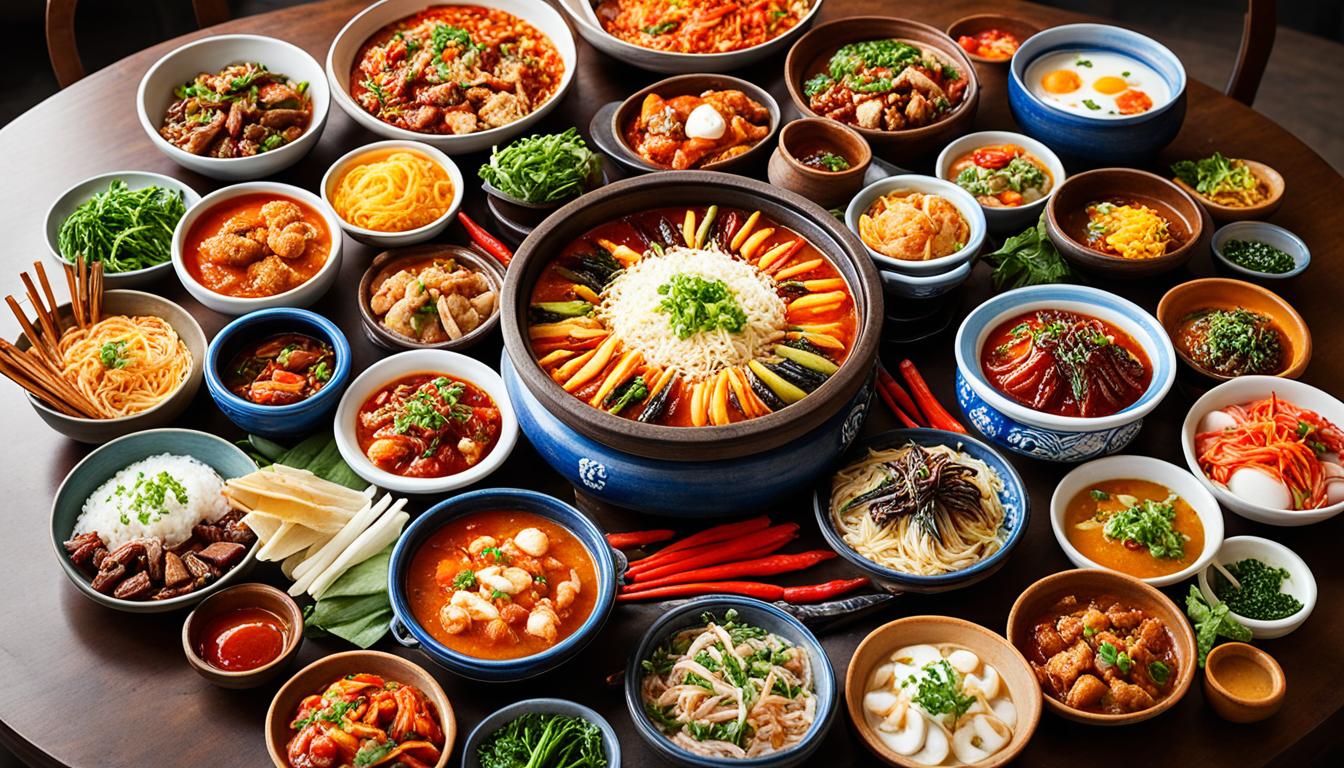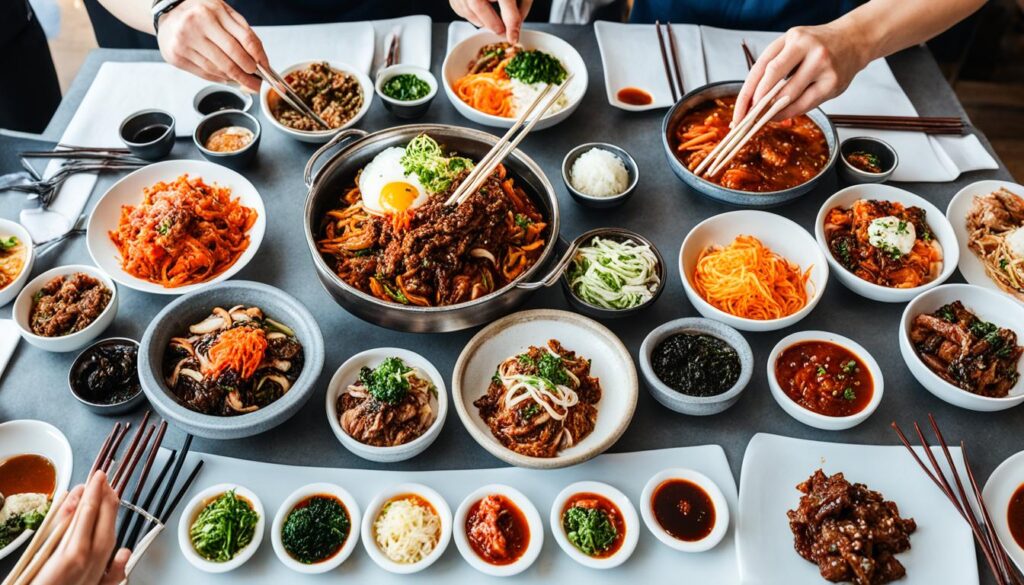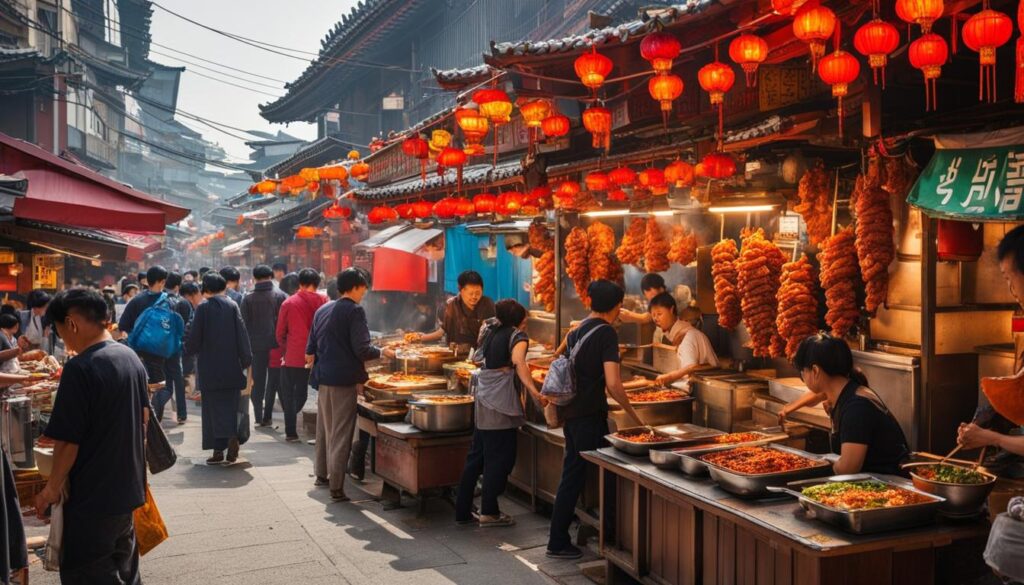
Ultimate Korean Food Guide for Culinary Explorers
Imagine yourself strolling through the vibrant streets of Seoul, your senses alive with the aroma of sizzling meats, the spicy tang of kimchi, and the enticing sights of bustling food stalls. As a true culinary explorer, your quest for new tastes and experiences brings you to the heart of Korean cuisine, renowned for its bold flavors and vibrant food culture.
Welcome to the ultimate Korean food guide, where we will take you on a mouthwatering journey through the diverse culinary landscape of Korea. From popular dishes that have captured the hearts of food lovers worldwide to the delightful realm of street food, prepare to immerse yourself in a world of tantalizing flavors and culinary delights.
Whether you’re a fan of fiery spices or crave the comforting embrace of savory dishes, Korean cuisine offers a treasure trove of culinary experiences waiting to be explored. Join us as we dive into the rich traditions, distinct regional specialties, and the vibrant street food scene that has captivated taste buds across the globe.
Get ready to embark on a gastronomic adventure that will leave you craving for more. Let’s discover the wonders of Korean cuisine together!
A Guide to Korean Cuisine by Region
Korean cuisine is influenced by different regions, each with its own unique culinary heritage. Let’s explore the diverse gastronomic offerings from the three main regions of Korea: the Northern Region, the Central Region, and the Southern Region.
The Northern Region
The Northern Region of Korea boasts a rich seafood culture, thanks to its proximity to the sea. Here, you can indulge in a variety of seafood dishes that are sure to tantalize your taste buds. Two notable dishes from this region include:
- Sundae: A popular Korean sausage made with various ingredients such as pig’s intestines, noodles, barley, and vegetables. It is usually served with a side of spicy sauce for dipping.
- Pyongyang Naengmyeon: A refreshing dish of cold buckwheat noodles topped with a tangy broth, pickled radish, cucumber, and slices of boiled beef or chicken.
The Central Region
In the Central Region of Korea, you’ll discover a culinary paradise that emphasizes fresh and locally sourced ingredients. This region offers a wide range of flavorful dishes. Here are two iconic dishes from the Central Region:
- Tteokguk: A traditional New Year’s soup made with sliced rice cakes, beef broth, and various toppings such as egg, meat, and vegetables.
- Jjimdak: A hearty dish consisting of steamed chicken, vegetables, and glass noodles, cooked in a savory soy-based sauce. Jjimdak is known for its robust flavors and tender meat.
The Southern Region
The Southern Region of Korea is famous for its vibrant street food culture, offering a wide array of delicious treats. Here are two popular dishes from the Southern Region:
- Haemul Jjigae: A spicy seafood stew made with various fresh seafood such as shrimp, clams, squid, and vegetables. It’s a hearty and comforting dish perfect for seafood lovers.
- Hotteok: A sweet and chewy pancake filled with brown sugar, cinnamon, and chopped nuts. This popular street food is loved for its warm and gooey center.
With its diverse gastronomic offerings, Korean cuisine truly has something for everyone. Whether you’re in the Northern Region, the Central Region, or the Southern Region, you’re bound to experience a culinary journey like no other.
A Guide to Popular Korean Dishes
Korean cuisine is renowned for its rich flavors and diverse range of dishes. From spicy and fermented to savory and grilled, Korean food has captivated taste buds all around the world. In this section, we will explore some of the most popular Korean dishes that you must try.
1. Kimchi
Kimchi is the epitome of Korean cuisine and is a staple in Korean households. This iconic dish consists of fermented vegetables, most commonly Napa cabbage, seasoned with chili pepper, garlic, ginger, and other spices. The result is a tangy and spicy side dish that pairs perfectly with rice and other main dishes.
2. Bibimbap
Bibimbap is a colorful and nutritious mixed rice bowl that showcases the beauty of Korean cuisine. It consists of a bed of steamed rice topped with an assortment of seasoned vegetables, meat (optional), and a fried egg. The dish is typically served with a dollop of gochujang, a spicy red pepper paste, which adds a delightful kick.
3. Dubu-jorim
Dubu-jorim is a popular vegetarian dish made with marinated tofu. The tofu is simmered in a savory sauce made with soy sauce, garlic, sesame oil, and other seasonings. The result is a flavorful and protein-rich dish that is often enjoyed as a side dish or as a main course with rice.
4. Galbi
Galbi, also known as Korean barbecue, is a beloved dish made with marinated beef or pork ribs. The meat is typically marinated in a sauce made with soy sauce, garlic, ginger, sesame oil, and other ingredients before being grilled to perfection. The result is tender and succulent ribs that are bursting with flavor.
These popular Korean dishes represent the rich culinary heritage and diversity of flavors that Korean cuisine has to offer. Whether you’re a fan of spicy kimchi, hearty bibimbap, flavorful dubu-jorim, or sizzling galbi, each dish will take your taste buds on a delightful journey through Korean gastronomy.
A Guide to Eating Habits in Korea
Korean dining etiquette is deeply rooted in tradition and reflects the country’s rich cultural heritage. Understanding and adhering to basic eating habits in Korea can enhance your dining experience and show respect for the local customs. In this section, we will explore the use of chopsticks and spoons, basic etiquette, and the significance of speed and placement during meals.
Chopsticks and Spoons
Korean cuisine is typically enjoyed with a combination of chopsticks and spoons. Chopsticks are used for picking up and eating non-liquid dishes, such as meats, vegetables, and side dishes. On the other hand, spoons are used for consuming rice, soups, and other liquid-based dishes.
Proper handling of chopsticks and spoons is important. When not in use, chopsticks should not be placed on top of the bowl or on other utensils. Instead, they should be rested on a chopstick holder or placed horizontally on the table.

Basic Etiquette
When dining in Korea, it’s important to observe some basic etiquette practices:
- Avoid blowing your nose or making loud noises while eating. It is considered impolite and disrespectful.
- Do not start eating until the eldest person at the table begins or until you are instructed to start.
- Take small bites and chew quietly to avoid drawing unnecessary attention to your meal.
- Refrain from sticking chopsticks upright in your rice bowl, as this is reminiscent of ancestral rituals and is considered disrespectful.
Speed and Placement
Speed and placement play significant roles in Korean dining culture. Korean meals are often served as a series of shared dishes. It is customary to wait for everyone to have their share of food before starting to eat. Once everyone is served, it is polite to wait for the eldest person at the table to begin eating.
The placement of bowls and utensils is also important. Bowls should be placed in the center of the table, and each person can serve themselves from the collective dishes. It is considered respectful to only take what you can finish to avoid wasting food.
Eating Habits in Korea:
| Eating Habits | Description |
|---|---|
| Using Chopsticks and Spoons | Chopsticks for non-liquid dishes, spoons for rice and soup |
| Proper Placement | Avoid placing chopsticks on utensils when not in use |
| Basic Etiquette | Avoid blowing nose, start eating after eldest person, chew quietly |
| Speed and Placement | Wait for everyone to be served, wait for eldest person to start eating, serve yourself from collective dishes |
By understanding and embracing the eating habits in Korea, you can fully appreciate the cultural nuances and enjoy an authentic dining experience. Respect for the local customs will not only demonstrate your cultural awareness but will also foster a deeper connection with the people and the cuisine of Korea.
Discovering Korean Street Food
Korean street food is a popular and delicious way to experience the vibrant flavors of Korean cuisine. From savory to sweet, the streets of Korea are filled with tantalizing treats that will leave your taste buds craving for more. Whether you’re exploring the bustling streets of Seoul or venturing off-the-beaten-path in a small alleyway, you’re bound to find a variety of delectable street foods that encapsulate the essence of Korean gastronomy.
Popular Street Foods
As you wander through the streets of Korea, you’ll come across several popular street foods that are loved by locals and tourists alike. Here are some must-try dishes:
- Tteokbokki: This spicy rice cake dish is a staple of Korean street food. Chewy rice cakes are simmered in a fiery gochujang (red chili pepper paste) sauce, creating a delicious combination of heat and sweetness.
- Soondae: A traditional blood sausage made with a mixture of pork blood, sweet potato noodles, and various seasonings. It is often served with a side of spicy mustard and is a popular street food snack.
- Gimbap: Similar to sushi, gimbap is a roll of rice, vegetables, and sometimes meat, wrapped in a sheet of seaweed. It’s a convenient and tasty street food that is perfect for a quick meal on the go.
- Dak Gangjeong: Crispy and flavorful, dak gangjeong is a popular Korean street food made with bite-sized pieces of seasoned fried chicken. It’s a favorite among locals and visitors for its addictive sweet and savory glaze.
- Twigim: Also known as Korean-style tempura, twigim refers to a variety of deep-fried snacks. From vegetables to seafood, you can find an assortment of crispy and delicious treats served piping hot from street food stalls.
These street foods offer a wide range of flavors and textures that are sure to satisfy any food lover. The combination of spices, sauces, and fresh ingredients creates a culinary experience that is unique to Korean street food culture.

Immerse yourself in the vibrant atmosphere of street food stalls, where the sizzle of the grill, the aroma of spices, and the hustle and bustle of customers create an unforgettable sensory experience. The mouthwatering delights of Korean street food will undoubtedly leave you craving for more.
Sweet Delights of Korean Street Food
In addition to the savory delicacies, Korean street food also offers a delectable selection of sweet treats. Indulge your taste buds with these delightful confections that are sure to satisfy your sweet tooth.
Bungeoppang: Fish-shaped Sweet Cakes
One of the most charming and popular sweet treats you’ll find on the streets of Korea is Bungeoppang. These adorable fish-shaped cakes are made from a crispy, golden batter and filled with a sweet red bean paste. The combination of the crunchy exterior and the smooth, luscious filling makes them a delightful treat to enjoy while meandering through the vibrant streets of Korea.
Hotteok: Sweet and Caramelly Pancakes
When it comes to Korean street food, Hotteok is a must-try. These fluffy pancakes are filled with a gooey and sweet mixture of brown sugar, cinnamon, and chopped nuts. As the hot pancake hits your tongue, the sweet filling oozes out, creating a heavenly flavor explosion. Whether you’re exploring the bustling markets or strolling along the lively alleys, Hotteok is a delightful snack that will leave you craving for more.
Gyeranppang: Golden Muffins with a Surprise
Gyeranppang is a scrumptious treat that combines the best of savory and sweet flavors. These golden muffins are topped with a whole egg, creating a moist and savory delight. As you take a bite, the creamy yolk blends with the fluffy muffin, offering a perfect balance of flavors. Often wrapped in a paper holder, Gyeranppang is a popular street food item that’s enjoyed by both locals and tourists alike.
So, don’t miss out on these sweet treasures while exploring the colorful streets of Korea. Each bite is an opportunity to experience the culinary delights of Korean street food.
Skewers and Snacks at Korean Street Stalls
Korean street stalls are a haven for food lovers, offering a wide array of delectable skewers and snacks that are perfect for enjoying on the go. One popular choice is kkochi, which are grilled skewers featuring tender chicken and green onion, all smothered in a tangy and flavorful barbecue sauce. The combination of savory meat and zesty sauce creates a mouthwatering experience that will leave you craving for more.
Another must-try snack at Korean street stalls is odeng, a beloved fish cake skewer that is served in a delicious and aromatic broth. The fish cake is tender and packed with umami flavors, making it a satisfying treat for any seafood enthusiast. As you savor the odeng skewer, the delicate broth infuses the fish cake with a comforting warmth that is perfect for chilly days or a quick pick-me-up.
For those who prefer a crispy and savory snack, the hot bar is a fantastic option. These skewers feature deep-fried fish cake paste and come in a variety of mouthwatering flavors. With each bite, you’ll experience a delightful crunch followed by a burst of rich flavors. From spicy to savory, the hot bar offers something for everyone and is an irresistible treat that you won’t want to miss while exploring the bustling streets of Korea.
Whether you’re a fan of grilled skewers, savory fish cakes, or crispy snacks, Korean street stalls have something to satisfy every palate. Head to the vibrant streets of Korea and indulge in the flavors of kkochi, odeng, and hot bar. These convenient and delicious street snacks are a true reflection of the vibrant and diverse culinary culture that Korea has to offer.
Source Links
- https://www.lonelyplanet.com/articles/best-street-food-south-korea
- https://jayatravel.com/korean-cuisine/
- https://www.amazon.in/Hangul-Explorers-Guide-Korean-Food-ebook/dp/B0CLKYRC72

Leave a Reply